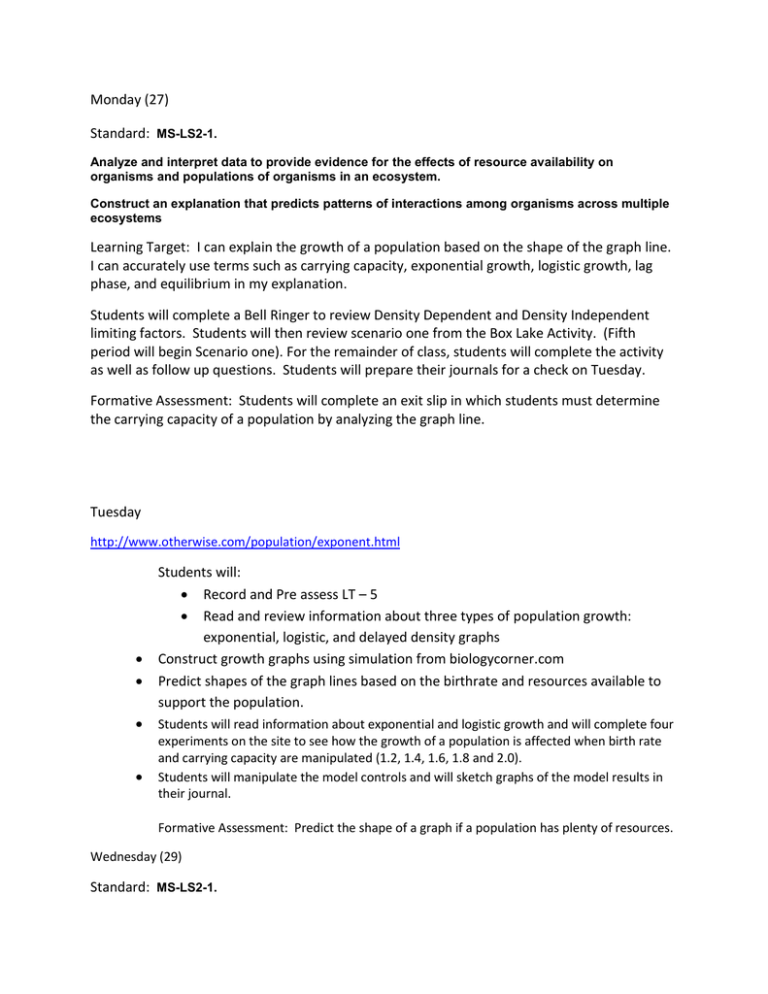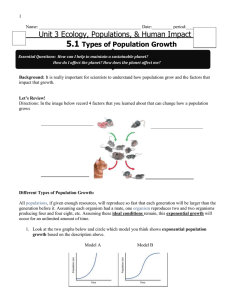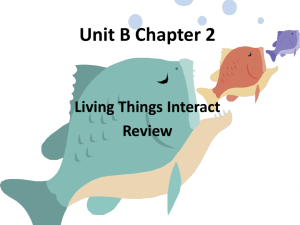Monday (27) Standard:
advertisement

Monday (27) Standard: MS-LS2-1. Analyze and interpret data to provide evidence for the effects of resource availability on organisms and populations of organisms in an ecosystem. Construct an explanation that predicts patterns of interactions among organisms across multiple ecosystems Learning Target: I can explain the growth of a population based on the shape of the graph line. I can accurately use terms such as carrying capacity, exponential growth, logistic growth, lag phase, and equilibrium in my explanation. Students will complete a Bell Ringer to review Density Dependent and Density Independent limiting factors. Students will then review scenario one from the Box Lake Activity. (Fifth period will begin Scenario one). For the remainder of class, students will complete the activity as well as follow up questions. Students will prepare their journals for a check on Tuesday. Formative Assessment: Students will complete an exit slip in which students must determine the carrying capacity of a population by analyzing the graph line. Tuesday http://www.otherwise.com/population/exponent.html Students will: Record and Pre assess LT – 5 Read and review information about three types of population growth: exponential, logistic, and delayed density graphs Construct growth graphs using simulation from biologycorner.com Predict shapes of the graph lines based on the birthrate and resources available to support the population. Students will read information about exponential and logistic growth and will complete four experiments on the site to see how the growth of a population is affected when birth rate and carrying capacity are manipulated (1.2, 1.4, 1.6, 1.8 and 2.0). Students will manipulate the model controls and will sketch graphs of the model results in their journal. Formative Assessment: Predict the shape of a graph if a population has plenty of resources. Wednesday (29) Standard: MS-LS2-1. Analyze and interpret data to provide evidence for the effects of resource availability on organisms and populations of organisms in an ecosystem. Standard: Construct an argument supported by empirical evidence that changes to physical or biological components of an ecosystem affect populations. Students will complete a bell ringer that identifies the parts of exponential growth graphs. Students will then complete the simulation they began yesterday using logistic growth (growth with a carrying capacity). Students will take a clicker test over LT 4 and LT 5. Thursday (30) Review the answers to the clicker quiz. Students will spend the rest of class time reviewing LT 4 and LT 5. Students will play Beach Ball Review and Whiteboard Review. A paper pencil study guide will be given to those students that would rather complete a traditional review sheet. Friday (1) Standard: MS-LS2-1. Analyze and interpret data to provide evidence for the effects of resource availability on organisms and populations of organisms in an ecosystem. Standard: Construct an argument supported by empirical evidence that changes to physical or biological components of an ecosystem affect populations. Students will take a Quiz over LT 4 and LT 5. Essential Question: Hey! What does that crawdad have to do with water quality? Learning Target: I can define benthic macro invertebrate and can explain how macros are used to assess water quality. Students will begin an inquiry activity by participating in a macro invertebrate sampling exercise called “Bioassess”. Students will work in small groups. Each group will “collect” a sample of macros from different points on the same river. After completing the sample, students will look for similar bugs in their sample (classifying). They will use an index key to determine if they are group 1, 2, or 3 macro invertebrates. Finally, they will follow the bio assessment form instructions to complete a “stream quality assessment form”. Students will compare their assessment scores.








